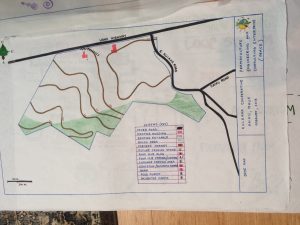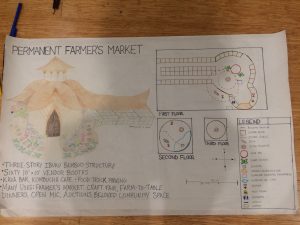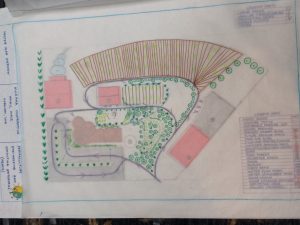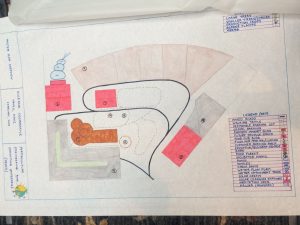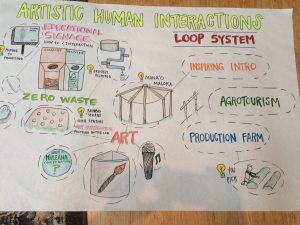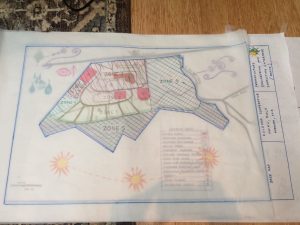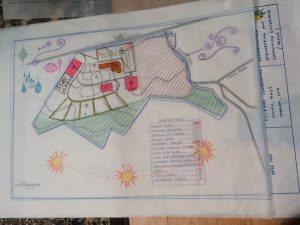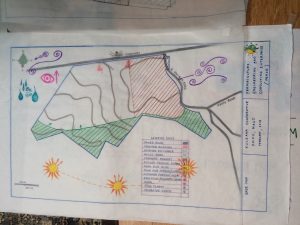This week we have been at Ahimsa Sanctuary Farm on the north shore of Maui, 14.5 miles down the road to Hana. We mostly dived into design methodology and approaches in preparation for our final permaculture design project.
When working on permaculture designs, the first step is to draw a base map. This is not to add anything new but to show all the existing elements and sectors on the land. “Design by elimination,” Jenny calls it. Examples of what can be included on this are: buildings, trees, topography, hydrology, boundaries, roads/access, utilities, ponds, archaeology, waste, wildlife corridors, easements, wells, fences, neighbors’ locations, wetlands, parking, geological features, and sacred sites. Base maps must include a compass rose, scale, legend, name/address/designer’s name, coordinates, sector analysis, and the date.
The next step is where the design work comes in: adding in elements. These typically fall into five categories: food, water, waste, energy, and natural building, but can include anything you can dream up. Examples we came up with in class are: a greenhouse, community space, windmill, orchard, compost, nursery, hearth, solar panels, composting toilet, outdoor shower, biodigester, swales, pond, farmstand, meditation space, worm bins, hot tub, art studio, kombucha/fermenting station, woodshop, forge, yoga space, sauna, office/library, chickens/goats/alpacas, bees, flow forms, dog house, recycling, shed, barn, and a makery/workshop. The possibilities are really endless.
It is important to consider how we can design the land to make money and support itself. The best (most cost-efficient) ways to do this are through design and consulting work and agrotourism. Other ways we discussed are value-added products, teaching, row crops, lotions and body care products, specialty crops, wellness programs (like raw food, yoga, and specialty education, u-pick, ferments, woody crops, hosting events and weddings, summer camps, recovery programs, natural building workshops, and mycology. Follow your passions and get creative! What unique service can you bring to the table?
From there we moved into design methodology and approach which has five main steps.
0. Have a contract signed, sealed, and delivered before you do any work.
1. Community Engagement: Learn the history, current story, and future outlook of the people. Source this information from the people in order to ensure you are in harmony with your surroundings.
2. Data Gathering: This includes ecological, social, cultural, material, and economic resource assessment, client interview, aerial photo, topography map, soil sampling and tests, geology, land capability, land use history, and local knowledge and context. The most important aspect of this step is the client interview, in which you should meet with all the stakeholders and board members, land owners, and community to gather information on the history of the project and people related to the land, the skill sets available, and the timeline and budget for the project.
3. Observations of the land.
4. Analysis of elements, zones, and sectors.
5. Feedback loop: in which you engage with the client to hone in the design.
This week we were assigned to our design teams and chose our final design project. My group consists of myself, Forrest, Foot, and Melo. We have chosen to design one of Jenny Pell’s projects that has been put on hold: a Food Hub for Maui farmers. This will include aggregation and distribution zones, a community space, incubator plots, a permanent farmer’s market, worker co-op, two commercial kitchens, poi-pounding factory, and more. By next week we are going to establish a team name, goals, a mission statement, branding, and a base map with sector analysis.
A less obvious part of permaculture is invisible structures, also known as social permaculture. This can be broken down into financial, legal, governance, social, land access, and community systems.
Financial: Examples include credit unions, conscious banking, green investing, tithes, higher minimum wage, alternative currencies, cryptocurrency, bartering, universal basic income, universal health care, and free university.
Legal: Examples are free legal services, mediation services, recoding groups, and co-ops.
Governance: There’s a wide range of governmental systems. Examples that include both poor and benevolent systems are: liquid democracies, authoritarian, dysfunctional democracy, corporatocracy, plutocracy, oligarchy, intuitive wisdom, grassroots, consensus, sociacracy, wholacracy, dynasty, council, anarchy, theocracy, capitalism, marxism, nepotism, democratic socialism, and dynamic governance.
Community: Includes co-ops for housing and food, intentional communities, shared housing, spiritual, cohousing, community land trust, condo associations, eco villages, agrihoods, permaculture developments.
We did not talk about social and land access invisible structures yet. Land access relates to who can access the land and how, and would include national parks and forests. Social permaculture relates to the principle of integration over segregation, building resilience by building community.
Maui is absolutely glorious. It was rainy the last couple days but now it’s cleared up, and we’re hosting a Maori water ceremony and gathering tonight at Ahimsa. Last night I went to my first ecstatic dance church and tomorrow we’re going whale watching!
Mahalo!
